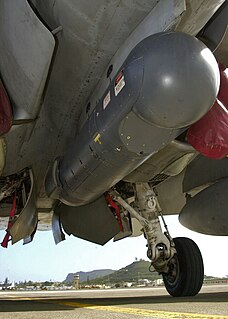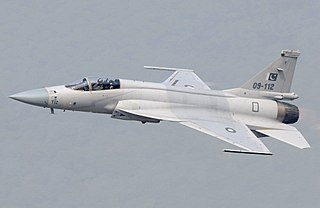
The Dassault Mirage III is a family of single/dual-seat, single-engine, fighter aircraft developed and manufactured by French aircraft company Dassault Aviation. It was the first Western European combat aircraft to exceed Mach 2 in horizontal flight, a feat which was achieved on October 24 1958, the English Electric Lightning achieving it on November 25 1958.

The SEPECAT Jaguar is an Anglo-French jet attack aircraft originally used by the British Royal Air Force and the French Air Force in the close air support and nuclear strike role. It is still in service with the Indian Air Force.

A laser-guided bomb (LGB) is a guided bomb that uses semi-active laser guidance to strike a designated target with greater accuracy than an unguided bomb. First developed by the United States during the Vietnam War, laser-guided bombs quickly proved their value in precision strikes of difficult point targets. These weapons use on-board electronics to track targets that are designated by laser, typically in the infrared spectrum, and adjust their glide path to accurately strike the target. Since the weapon is tracking a light signature, not the object itself, the target must be illuminated from a separate source, either by ground forces, by a pod on the attacking aircraft, or by a separate support aircraft. Data from the 28,000 laser guided bombs dropped in Vietnam showed that laser-guided bombs achieved direct hits nearly 50% of the time, despite the laser having to be aimed out the side window of the back seat of another aircraft in flight. Unguided bombs had an accuracy rate of just 5.5% per mission, which usually included large numbers of the munitions. Because of this dramatically higher precision, laser-guided munitions can carry less explosive and cause less collateral damage than unguided munitions. Today, laser-guided bombs are one of the most common and widespread guided bombs, used by many of the world's air forces.

The Dassault Mirage 2000 is a French multirole, single-engined, fourth-generation jet fighter manufactured by Dassault Aviation. It was designed in the late 1970s as a lightweight fighter to replace the Mirage III for the French Air Force. The Mirage 2000 evolved into a multirole aircraft with several variants developed, with sales to a number of nations. It was later developed into the Mirage 2000N and 2000D strike variants, the improved Mirage 2000-5, and several export variants. Over 600 aircraft were built and it has been in service with 9 nations.

Low Altitude Navigation and Targeting Infrared for Night, or LANTIRN, is a combined navigation and targeting pod system for use on the United States Air Force fighter aircraft — the F-15E Strike Eagle and F-16 Fighting Falcon. LANTIRN significantly increases the combat effectiveness of these aircraft, allowing them to fly at low altitudes, at night and under-the-weather to attack ground targets with a variety of precision-guided weapons.

The Dassault Mirage 2000N is a variant of the Mirage 2000 designed for nuclear strike. It formed the core of the French air-based strategic nuclear deterrent. The Mirage 2000D is its conventional attack counterpart.

A laser designator is a laser light source which is used to designate a target. Laser designators provide targeting for laser-guided bombs, missiles, or precision artillery munitions, such as the Paveway series of bombs, AGM-114 Hellfire, or the M712 Copperhead round, respectively.

The Texas Instruments BOLT-117, retrospectively redesignated as the GBU-1/B was the world's first laser-guided bomb (LGB). It consisted of a standard M117 750-pound bomb case with a KMU-342 laser guidance and control kit. This consisted of a gimballed laser seeker on the front of the bomb and tail and control fins to guide the bomb to the target. The latter used the bang-bang method of control where each control surface was either straight or fully deflected. This was inefficient aerodynamically, but reduced costs and minimized demands on the primitive onboard electronics.

Targeting pods (TGP) are target designation tools used by ground-attack aircraft for identifying targets and guiding precision guided munitions (PGM) such as laser-guided bombs to those targets. The first targeting pods were developed in conjunction with the earliest generation of PGMs in the mid-1960s.

The AN/AAQ-28(V) LITENING targeting pod is an advanced precision targeting pod system currently operational with a wide variety of aircraft worldwide. The research and development of the LITENING was first undertaken by Rafael Advanced Defense Systems' Missiles Division in Israel, with subsequent completion of LITENING I for use in the Israeli Air Force.

The PAC JF-17 Thunder, or CAC FC-1 Xiaolong, is a lightweight, single-engine, fourth-generation multi-role combat aircraft developed jointly by the Pakistan Aeronautical Complex (PAC) and the Chengdu Aircraft Corporation (CAC) of China. It was designed to replace the A-5C, F-7P/PG, Mirage III, and Mirage V combat aircraft in the Pakistan Air Force (PAF). The JF-17 can be used for multiple roles, including interception, ground attack, anti-ship, and aerial reconnaissance. Its designation "JF-17" by Pakistan is short for "Joint Fighter-17", while the designation and name "FC-1 Xiaolong" by China means "Fighter China-1 Fierce Dragon".

A guided bomb is a precision-guided munition designed to achieve a smaller circular error probable (CEP).

The Type 730 is a Chinese seven-barrelled 30 mm Gatling gun CIWS. It has a PLA Navy designation H/PJ12. It is mounted in an enclosed automatic turret and directed by radar, and electro-optical tracking systems. The maximum rate of fire is 5800 rd/m, and the effective range is up to 3 km.

The Pakistan Aeronautical Complex, or PAC) is a major defense contractor and an aerospace manufacturer that is headquartered in Kamra, Punjab, Pakistan.

Project ROSE, was a program initiated by the Pakistan Air Force (PAF) Pakistan Aeronautical Complex for the upgrades of the military avionics and electronics system of its aging Mirage III fighter jets, which had been built in either France or in Australia. The program focused on modernization of military avionics and on-board computer system of Mirage IIIE and the Mirage 5 supplied by Pakistani Margella Electronics, French SAGEM and the Italian SELEX consortiums, as part of the program.

The SNEB rocket is an unguided air-to-ground 68 mm (2.7 in) rocket projectile (RP) manufactured by the French company TDA Armements, designed for launch by combat aircraft and helicopters. It is also known as the SNEB rocket pod, and sometimes as the Matra rocket, due to it commonly being carried in pod-like launchers built by Matra.

The AS-30 was an air-to-ground missile built by Nord Aviation. It was a precision attack weapon designed to be used against high-value targets such as bridges and bunkers. The AS-30 was essentially a larger version of the earlier AS-20 design, and initially used that weapon's guidance system, which required pilots to track the weapon visually and correct its path using a small joystick, while also flying their own aircraft. All such MCLOS systems proved very difficult to use in practice. The updated AS-30L replaced this system with a semi-active laser homing system, which allows the missile to fly to the target without operator intervention. About 60 AS-30Ls were launched during Operation Desert Storm and Operation Deliberate Force with great success.

The Damocles is a 3rd generation targeting pod, modular, eye-safe laser, high performance pod selected by the French Air Force for its attack fighter aircraft fleet. It first entered service in 2009.

A precision-guided munition is a guided munition intended to precisely hit a specific target, to minimize collateral damage and increase lethality against intended targets. During the First Gulf War guided munitions accounted for only 9% of weapons fired, but accounted for 75% of all successful hits. Despite guided weapons generally being used on more difficult targets, they were still 35 times more likely to destroy their targets per weapon dropped.

Sudarshan is an Indian laser-guided bomb kit, developed by Aeronautical Development Establishment (ADE), a DRDO lab with technological support from another DRDO lab Instruments Research and Development Establishment (IRDE), for the Indian Air Force (IAF).



















